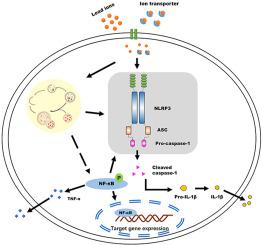当前位置:
X-MOL 学术
›
Environ. Pollut.
›
论文详情
Our official English website, www.x-mol.net, welcomes your feedback! (Note: you will need to create a separate account there.)
The role of NLRP3 in lead-induced neuroinflammation and possible underlying mechanism
Environmental Pollution ( IF 8.9 ) Pub Date : 2021-06-15 , DOI: 10.1016/j.envpol.2021.117520 Peng Su 1 , Diya Wang 1 , Zipeng Cao 1 , Jingyuan Chen 1 , Jianbin Zhang 1
Environmental Pollution ( IF 8.9 ) Pub Date : 2021-06-15 , DOI: 10.1016/j.envpol.2021.117520 Peng Su 1 , Diya Wang 1 , Zipeng Cao 1 , Jingyuan Chen 1 , Jianbin Zhang 1
Affiliation

|
Neuroinflammation induced by lead exposure (Pb) is a major cause of neurotoxicity of Pb in the central nervous system (CNS). The NLR family, domain of pyrin containing 3 (NLRP3) involves in various neurological diseases, while the question of whether NLRP3 plays a role in lead-induced neuroinflammation has not yet been reported. Developmental and knockout (KO) NLRP3 mice were used to establish two models, and BV2 cells were used to establish an model. Behavioral and electrophysiologic tests were used to assess the neurotoxicity of Pb, and immunofluorescence staining was used to assess neuroinflammation. Real-time PCR and western blot were performed to examine the mRNA and protein levels of inflammatory cytokines and NLRP3 inflammasomes. siRNA technology was used to block NLRP3 expression. Pb exposure led to neural injure and microglial activation in the hippocampus region, while minocycline intervention attenuated Pb-induced neurotoxicity by inhibiting neuroinflammation. Pb increased the expression of NLRP3 and promoted cleavage of caspase-1 in mRNA and protein levels, and minocycline partially reversed the effects of Pb on NLRP3 inflammasomes. Blocking of NLRP3 by KO mice or siRNA attenuated neural alterations induced by Pb, weakened microglial activation and as well, without affecting the accumulation of Pb. Pb increased autophagic protein levels and phosphorylation of NF-κB, while suppressing autophagy or NF-κB inhibited Pb's effects on NLRP3. NLRP3 is involved in the regulation of Pb-induced neurotoxicity. These findings expand mechanism research of Pb neurotoxicity and may help establish new prevention strategies for Pb neurotoxicity.
中文翻译:

NLRP3在铅诱导的神经炎症中的作用及其可能的机制
铅暴露 (Pb) 引起的神经炎症是中枢神经系统 (CNS) 中铅神经毒性的主要原因。 NLR家族,含有pyrin的结构域3(NLRP3)涉及多种神经系统疾病,而NLRP3是否在铅诱导的神经炎症中发挥作用的问题尚未见报道。采用发育型和敲除型(KO)NLRP3小鼠建立两种模型,并采用BV2细胞建立模型。行为和电生理测试用于评估铅的神经毒性,免疫荧光染色用于评估神经炎症。进行实时 PCR 和蛋白质印迹来检查炎症细胞因子和 NLRP3 炎症小体的 mRNA 和蛋白水平。使用siRNA技术来阻断NLRP3的表达。铅暴露会导致海马区的神经损伤和小胶质细胞激活,而米诺环素干预则通过抑制神经炎症来减轻铅诱导的神经毒性。 Pb增加NLRP3的表达并促进caspase-1在mRNA和蛋白水平上的裂解,米诺环素部分逆转Pb对NLRP3炎症小体的影响。 KO 小鼠或 siRNA 阻断 NLRP3 可减弱 Pb 诱导的神经改变,减弱小胶质细胞的激活,并且不影响 Pb 的积累。 Pb 增加自噬蛋白水平和 NF-κB 磷酸化,同时抑制自噬或 NF-κB 抑制 Pb 对 NLRP3 的影响。 NLRP3 参与 Pb 诱导的神经毒性的调节。这些发现拓展了铅神经毒性机制的研究,可能有助于建立铅神经毒性的新预防策略。
更新日期:2021-06-15
中文翻译:

NLRP3在铅诱导的神经炎症中的作用及其可能的机制
铅暴露 (Pb) 引起的神经炎症是中枢神经系统 (CNS) 中铅神经毒性的主要原因。 NLR家族,含有pyrin的结构域3(NLRP3)涉及多种神经系统疾病,而NLRP3是否在铅诱导的神经炎症中发挥作用的问题尚未见报道。采用发育型和敲除型(KO)NLRP3小鼠建立两种模型,并采用BV2细胞建立模型。行为和电生理测试用于评估铅的神经毒性,免疫荧光染色用于评估神经炎症。进行实时 PCR 和蛋白质印迹来检查炎症细胞因子和 NLRP3 炎症小体的 mRNA 和蛋白水平。使用siRNA技术来阻断NLRP3的表达。铅暴露会导致海马区的神经损伤和小胶质细胞激活,而米诺环素干预则通过抑制神经炎症来减轻铅诱导的神经毒性。 Pb增加NLRP3的表达并促进caspase-1在mRNA和蛋白水平上的裂解,米诺环素部分逆转Pb对NLRP3炎症小体的影响。 KO 小鼠或 siRNA 阻断 NLRP3 可减弱 Pb 诱导的神经改变,减弱小胶质细胞的激活,并且不影响 Pb 的积累。 Pb 增加自噬蛋白水平和 NF-κB 磷酸化,同时抑制自噬或 NF-κB 抑制 Pb 对 NLRP3 的影响。 NLRP3 参与 Pb 诱导的神经毒性的调节。这些发现拓展了铅神经毒性机制的研究,可能有助于建立铅神经毒性的新预防策略。



























 京公网安备 11010802027423号
京公网安备 11010802027423号